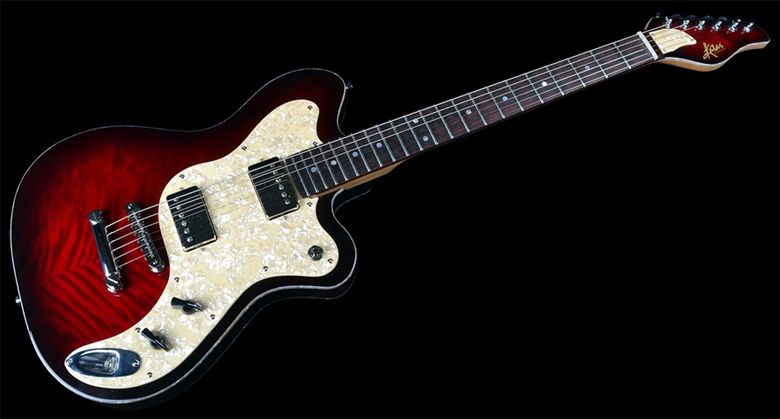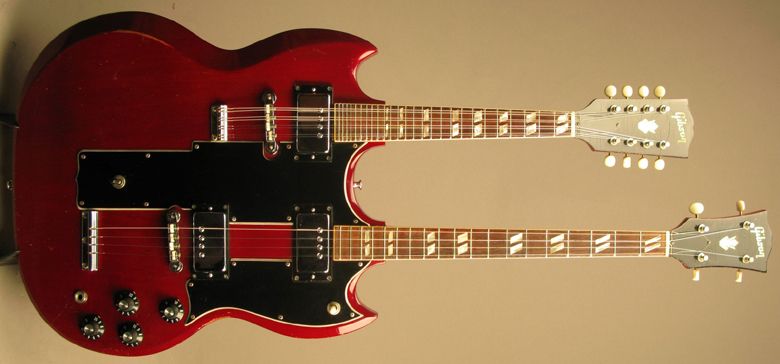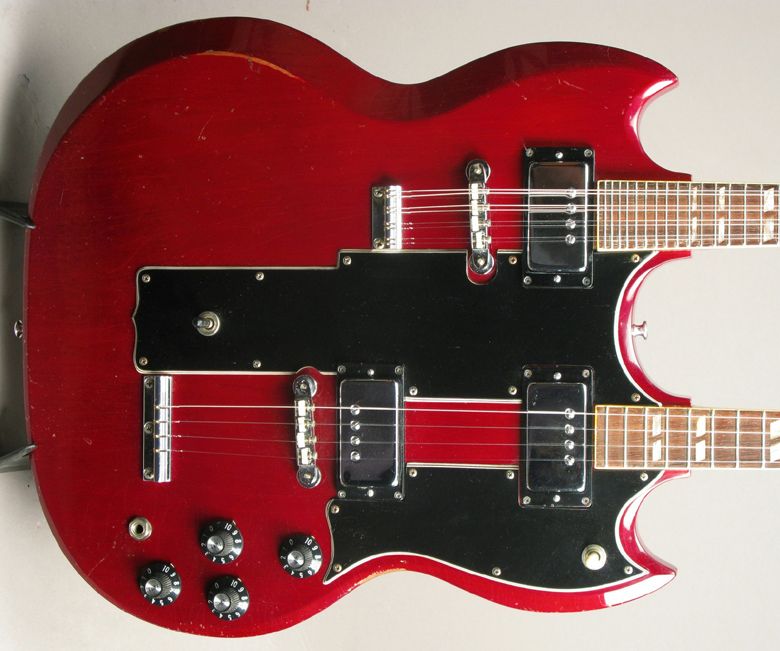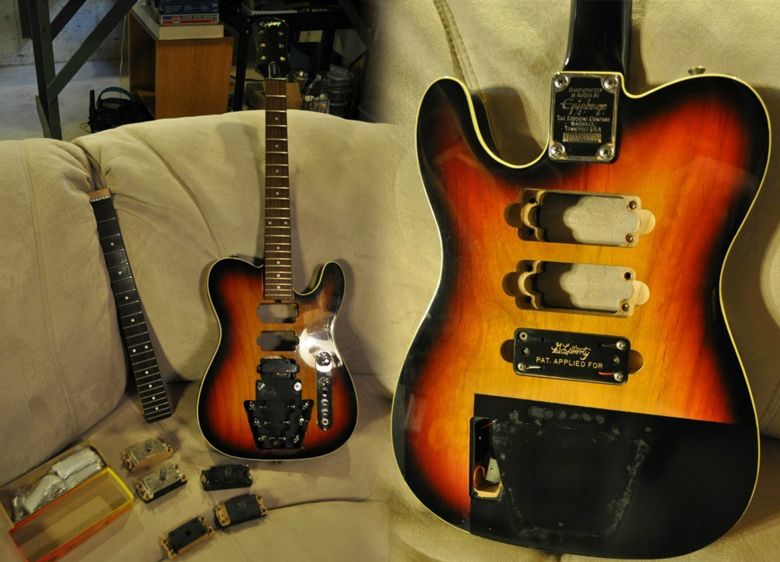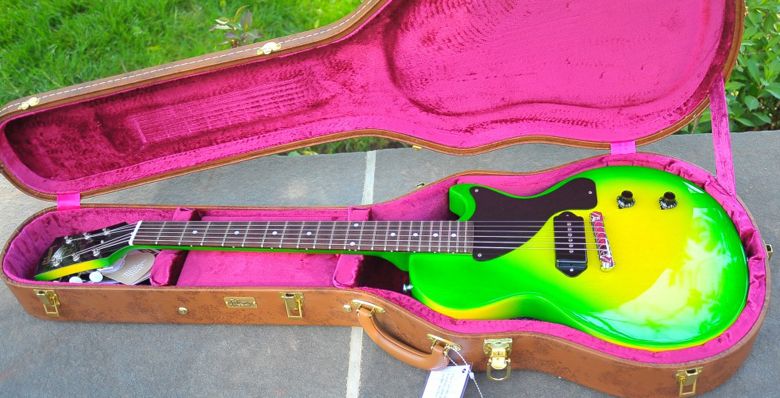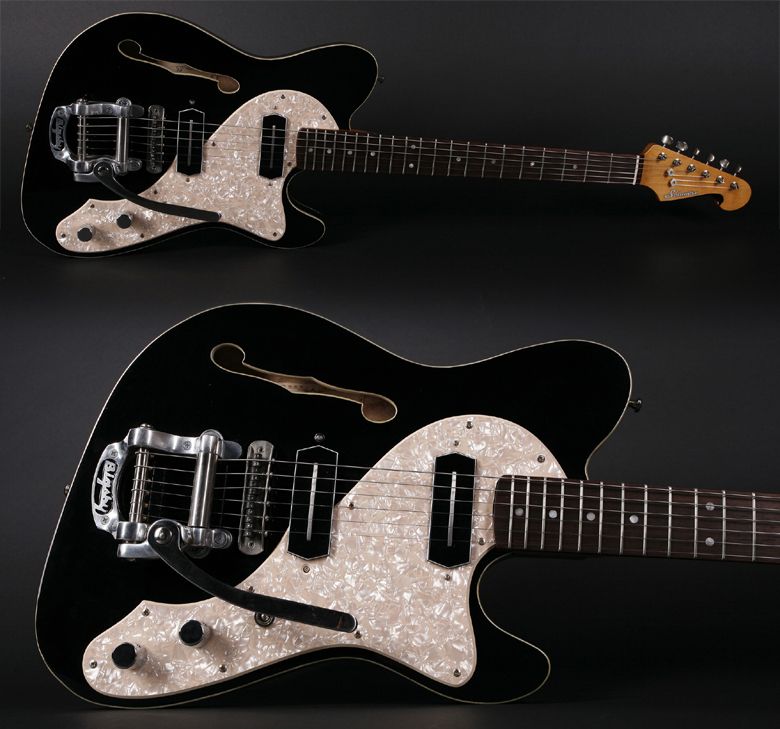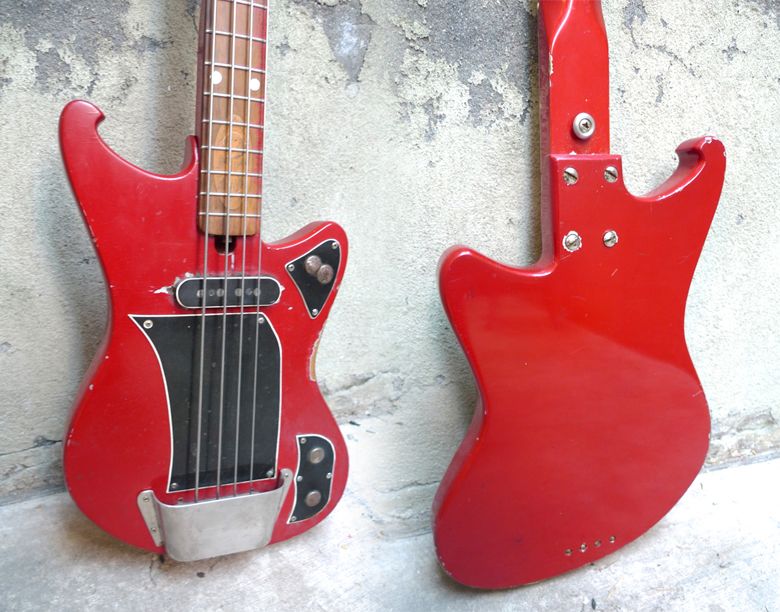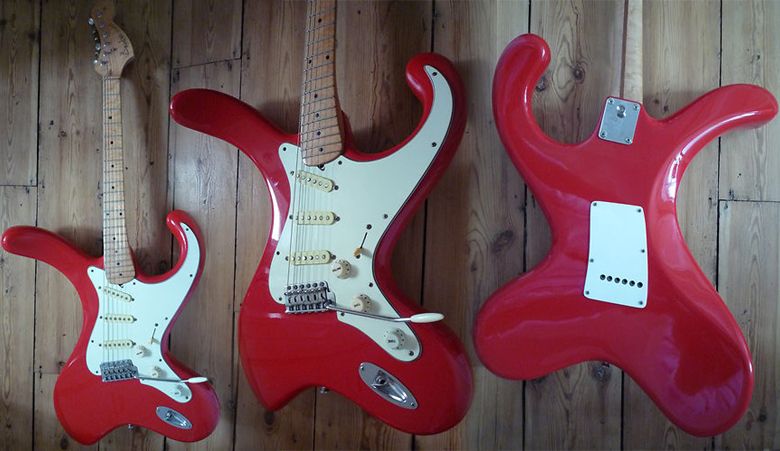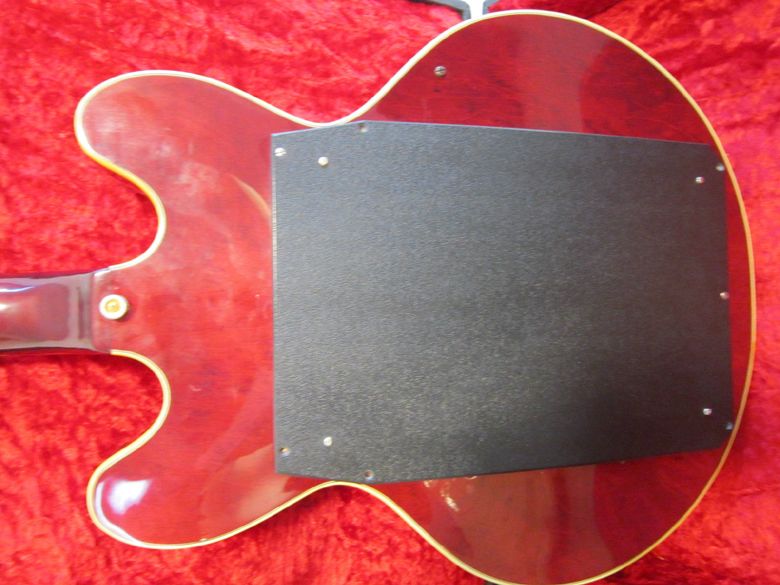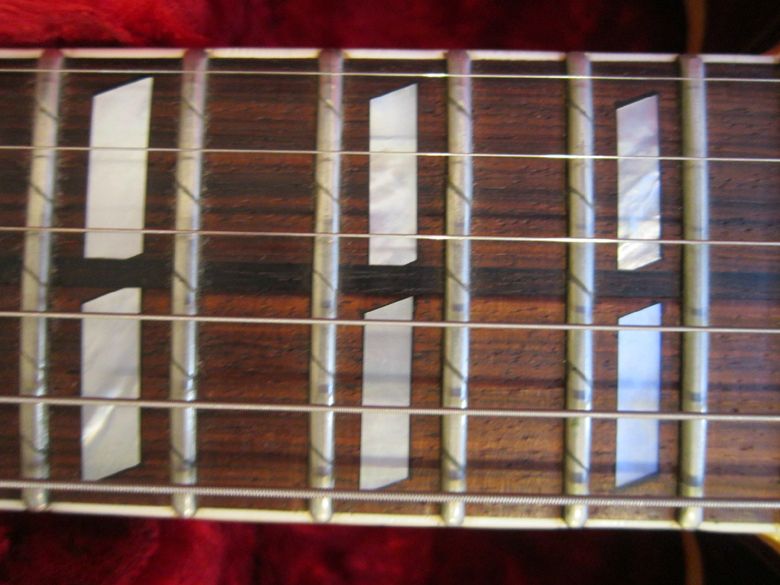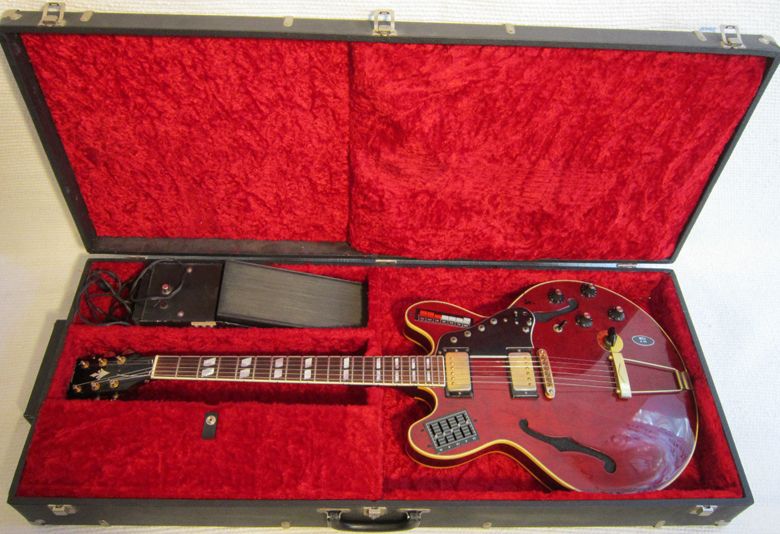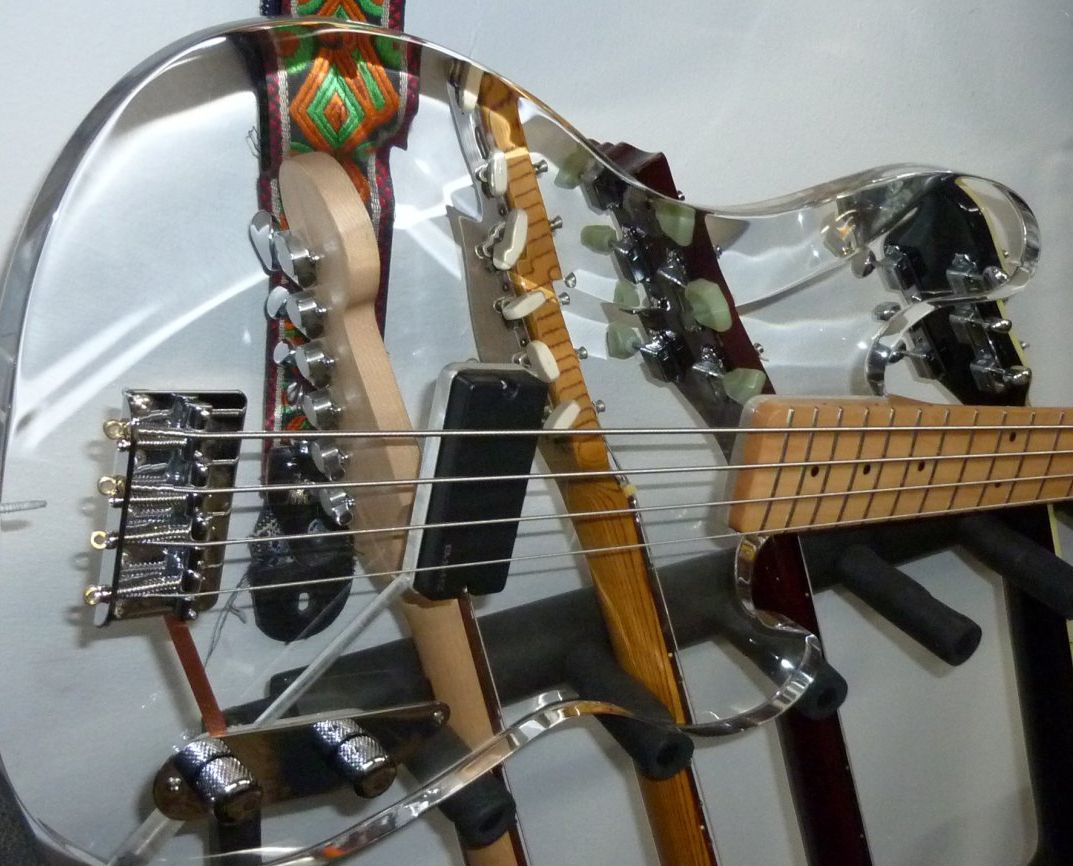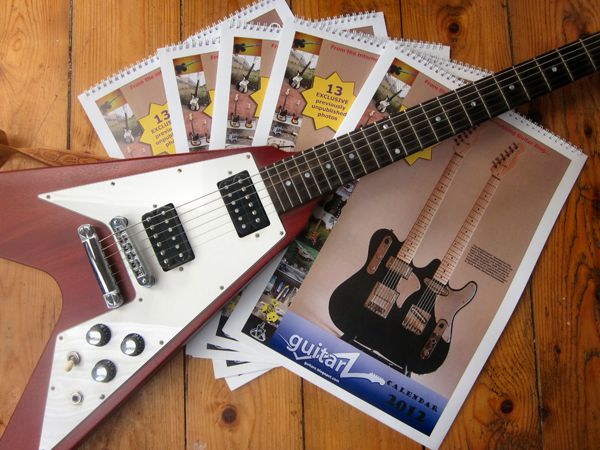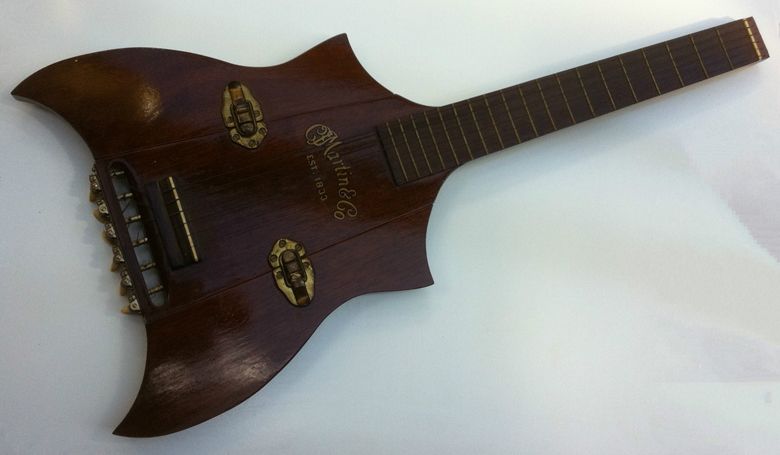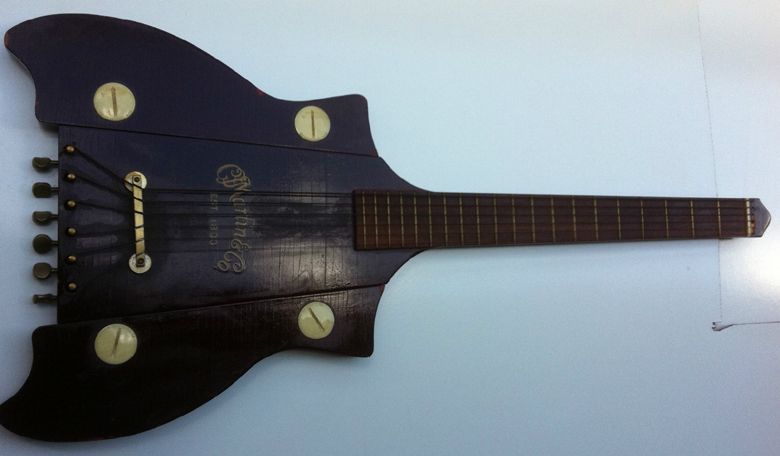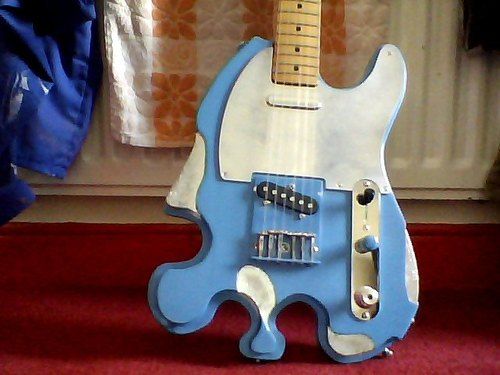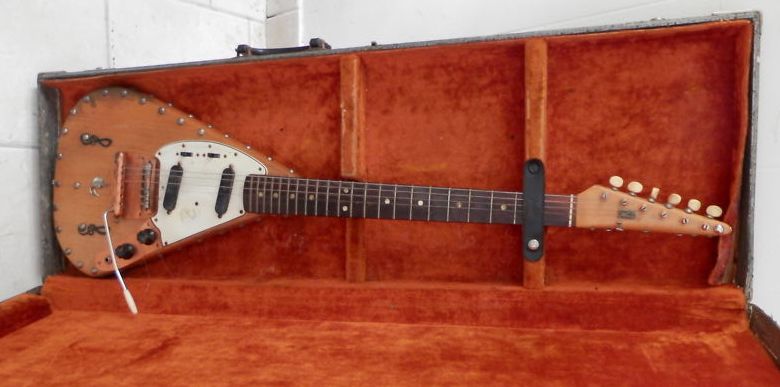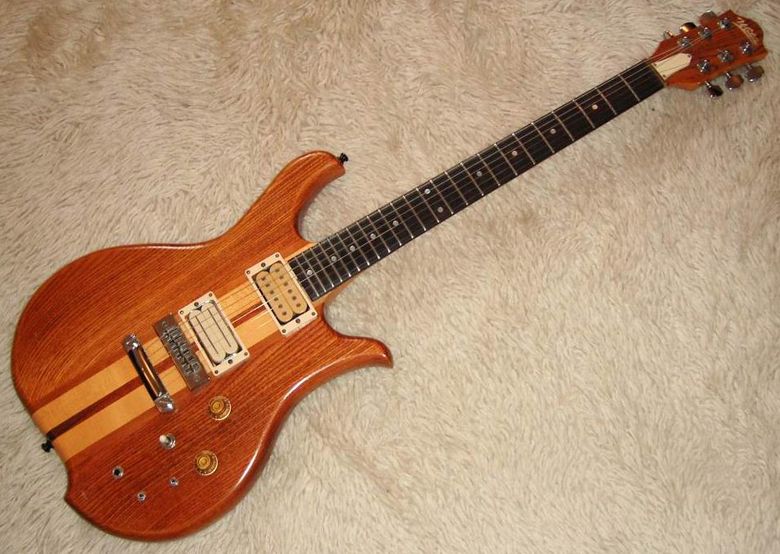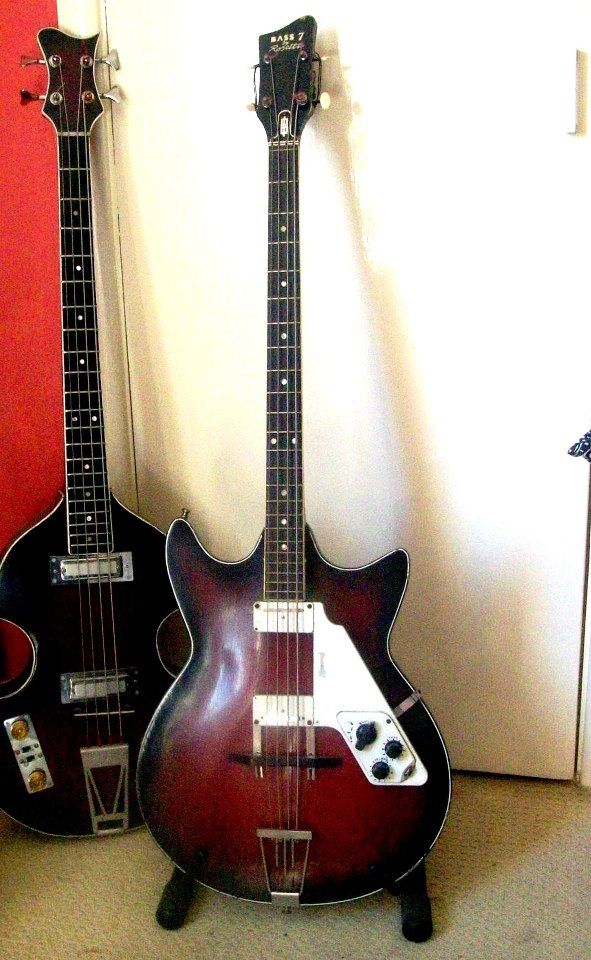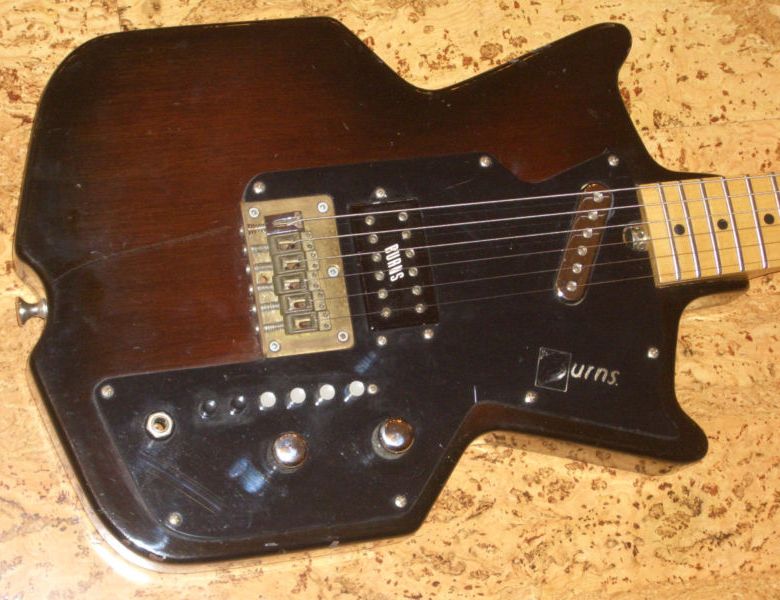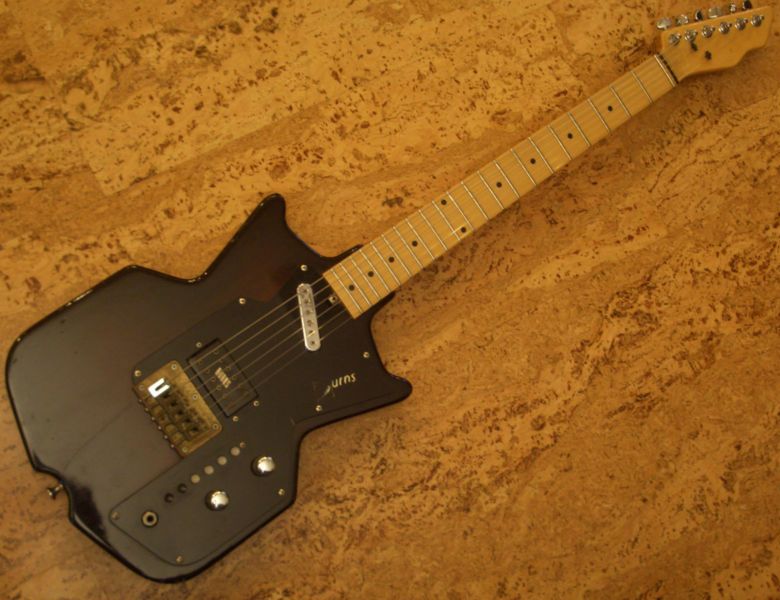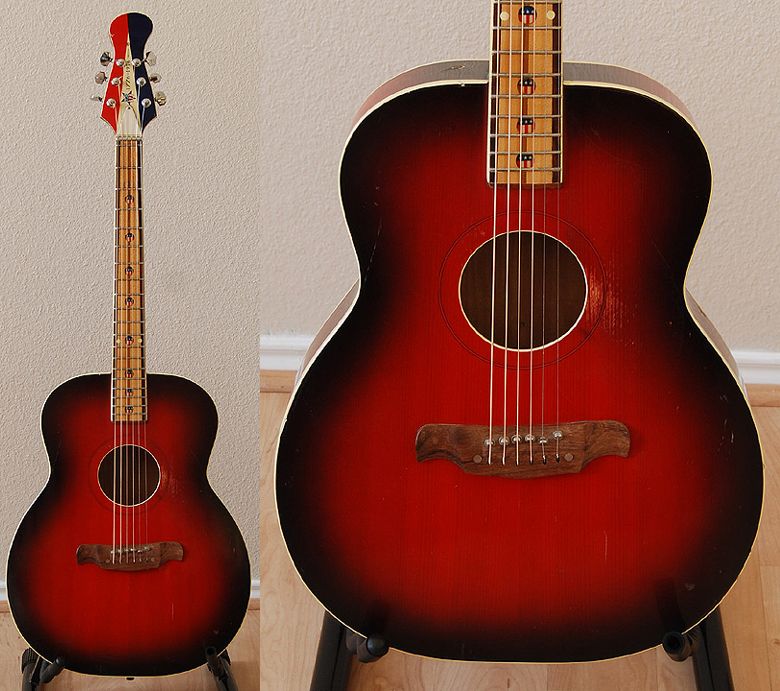guitarz.blogspot.com:
Here at Guitarz we don't just celebrate only vintage guitars, we also take an interest in contemporary instruments. Katar Kustom Kuitars (their spelling!) are a boutique maker from Finland specializing in Custom Shop instruments. As well as guitars obviously styled after certain famous Fender and Gibson models, Katar also offer some original designs such as the Popmaster which is delightfully retro in its design having the vibe of some of those old Danelectro and Kay guitars, but obviously with much higher production values.
This particular guitar is being sold by Amplisonic Ltd of Finland via Vintage & Rare and is priced at €3800.
G L Wilson
© 2012, Guitarz - The Original Guitar Blog - 10 years and counting!
Sunday 30 September 2012
Friday 28 September 2012
1967 Gibson EMS-1235 doubleneck tenor guitar and mandolin
guitarz.blogspot.com:
Of all the doublenecks ever produced, those made by Gibson must be the most easily recognized (no doubt helped in no small part by Jimmy Page), but they didn't just produce 12-string/6-sting and bass/6-string combinations.
Here we see a super rare Gibson EMS-1235 doubleneck that pairs together a 4-string tenor guitar with a mandolin. It would appear to be a custom order, handmade by master craftsman William Westman in 1967. Note the pickups which are full 6-string sized but only have 4 polepieces.
Currently listed on eBay with a Buy It Now price of $12,995. Also, see here for another unusual Gibson doubleneck.
G L Wilson
© 2012, Guitarz - The Original Guitar Blog - 10 years and counting!
Of all the doublenecks ever produced, those made by Gibson must be the most easily recognized (no doubt helped in no small part by Jimmy Page), but they didn't just produce 12-string/6-sting and bass/6-string combinations.
Here we see a super rare Gibson EMS-1235 doubleneck that pairs together a 4-string tenor guitar with a mandolin. It would appear to be a custom order, handmade by master craftsman William Westman in 1967. Note the pickups which are full 6-string sized but only have 4 polepieces.
Currently listed on eBay with a Buy It Now price of $12,995. Also, see here for another unusual Gibson doubleneck.
G L Wilson
© 2012, Guitarz - The Original Guitar Blog - 10 years and counting!
Thursday 27 September 2012
What's that guitar that Tom Cullinan from Quickspace is playing?
guitarz.blogspot.com:
James writes:
G L Wilson
© 2012, Guitarz - The Original Guitar Blog - 10 years and counting!
James writes:
Hey, I've been following your guitar blog for a long time now and it is great. I check it every day.Hi James, it looks to be a Vox Clubman. This would be an early 1960s, Made in Dartford, Kent, UK, Jennings Musical Industries (JMI) Vox, before guitar production was outsourced to the Eko factory in Italy. If it is anything like the Vox Clubman II that I used to own (the II had a different body shape), then it's a very basic student model with a very thin (approx 1" thick) plywood body, and non-adjustable trussrod in the neck (basically just a neck with a steel bar beneath the fingerboard). From the picture you have supplied, it looks like this example has been modified with tuners moved to both sides of what was once a 6-in-a-line headstock.
I was wondering since you seems like an expert in guitar identification, if you can tell me what guitar is pictured in the attached image? It' the guitar played by Tom Cullinan who played in a band called Quickspace. I've been trying to figure it out for ages. Sorry I couldn't get a better picture.
Your help would be much appreciated.
Cheers,
James.
G L Wilson
© 2012, Guitarz - The Original Guitar Blog - 10 years and counting!
Wednesday 26 September 2012
Lu Edmonds plays the electric saz with Public Image Ltd
guitarz.blogspot.com:
Another fine clip from last night's Later... with Jools Holland.
www.pilofficial.com
G L Wilson
© 2012, Guitarz - The Original Guitar Blog - 10 years and counting!
www.pilofficial.com
G L Wilson
© 2012, Guitarz - The Original Guitar Blog - 10 years and counting!
Muse perform "Madness" with doubleneck bass / Misa Kitara
guitarz.blogspot.com:
Whilst I confess that I'm not really a fan of Muse, I have to admit that they do use some very interesting instruments. Frontman Matt Bellamy is of course known for sometimes using a guitar with on-board Kaoss pad which he uses to control various effects. In this clip from Later... with Jools Holland, broadcast live last night on BBC2 in the UK, we see Christopher Wolstenholme playing a doubleneck bass guitar/Misa Kitara.
G L Wilson
© 2012, Guitarz - The Original Guitar Blog - 10 years and counting!
G L Wilson
© 2012, Guitarz - The Original Guitar Blog - 10 years and counting!
Tuesday 25 September 2012
Weird Telecaster with tuners in body and modular pickup system
guitarz.blogspot.com:
Let me quote from the eBay listing for this guitar:
Currently being auctioned on eBay.
G L Wilson
© 2012, Guitarz - The Original Guitar Blog - 10 years and counting!
Let me quote from the eBay listing for this guitar:
This listing is for a funky Telecaster project that I have had sitting around for about a year now. It is a 80s era telecaster body from SF guitar works. It has the name stamped in the neck pocket. The body has been HEAVILY modified to have 3 removable pickups. The tuning keys were also set into the body where the bridge would go. The pickups snap into the guitar from the backside and could be put in any position. They could also be inserted in reverse so I guess that would change the polarity? The power is routed to the pickups via 4 banana plugs which also hold them into the body.Indeed, it's an intriguing guitar. I do wonder about the validity of mounting an Epiphone neck (very likely intended for a 24 3/4" scale length) onto a Fender type body (designed for a 25 1/2" scale); the intonation implications could well be hideous. I've also seen these rear-mounted pickup systems before, usually used as "testbed" guitars by luthiers or pickup manufacturers.
[...]
The tuners set into the body are Gotoh style (might be the real thing but am not sure) and the bridge is a 80's era Gibson tune-o-matic. The neck that is on it is a 97 Epiphone Korean made LP 100 neck that I had sitting around. I worked on it a little to fit into the body which it fits very nice but it seems to sit a little high in the pocket. It does not have the tuning keys on it as I had a different plan for the headstock and didn't need them. I also used the Epiphone mounting screws and neckplate to mount the neck. I am also going to include the funky neck that was on it. It is definately a tele or strat style neck but the headstock is cut off and it is modified to have the string ends up there instead of the body (remember the set in tuners in the body?). It has a rosewood fret board and very nice frets. It is older but I have no idea who made it though. I am going to include the pickups that came with the guitar and a set of brand new hot rails from GFS too. The pick ups are 3 strat style single coils (no idea who made them), a EMG single coil, a Seymour Duncan Humbucker (No idea of the model but it is USA made), a "mystery" humbucker (could be another SD but it is not marked although it is nice quality) and 3 Guitar Fetish hot rail strat pickups. All the pickups work and have enough wire to add them to the "cartridges" that hold them into the body. The pickup holders are made with the name "G Liberty" and "pat applied for" but I have not found any info on this person or design. Obviously they were CNC made (as were all the body mods for that matter) There are 6 of them and are made out of hardwood (Maple?) except for one which looks like pine. (Prototype maybe?) They also have a spring in the middle to adjust the pickup height. There is really so much unknown about this guitar really but whoever "G Liberty" is they were pretty crafty and innovative...
Currently being auctioned on eBay.
G L Wilson
© 2012, Guitarz - The Original Guitar Blog - 10 years and counting!
Monday 24 September 2012
Gibson Les Paul Jnr 2012 Custom Shop in fluorescent limeburst finish
guitarz.blogspot.com:
Those of a nervous disposition, or recovering from a hangover, may want to reach for the sunglasses. I'm sure the rather OTT limeburst finish on this Limited Edition 2012 Custom Shop Les Paul Junior won't be to everyone's tastes. For myself, I'm more shocked that such a basic design of guitar is being offered here with a $2,990 Buy It Now price tag.
G L Wilson
© 2012, Guitarz - The Original Guitar Blog - 10 years and counting!
Those of a nervous disposition, or recovering from a hangover, may want to reach for the sunglasses. I'm sure the rather OTT limeburst finish on this Limited Edition 2012 Custom Shop Les Paul Junior won't be to everyone's tastes. For myself, I'm more shocked that such a basic design of guitar is being offered here with a $2,990 Buy It Now price tag.
G L Wilson
© 2012, Guitarz - The Original Guitar Blog - 10 years and counting!
Sunday 23 September 2012
Vintage & Rare Guitar of the Week: Schwarz Custom Guitars Supercharger "Little Charlie"
guitarz.blogspot.com:
It's funny how a little twist on an established design can sometimes give it a lease of new life. From Germany, this Schwarz Custom Guitars Supercharger "Little Charlie" model takes a Bigsby-equipped Telecaster Thinline and gives it the offset waist treatment. Design-wise it works beautifully; you have to question why no-one thought of it before. (Or perhaps they did... observations on this matter in the comments please!) The guitar also features a pair of Charlie Christian style pickups, which I'd imagine are the reason for its "Little Charlie" nickname.
Specs:
Priced at €2390 and available via Vintage & Rare. See www.schwarz-custom.de and/or www.gitarren-studio-neustadt.de for further information.
G L Wilson
© 2012, Guitarz - The Original Guitar Blog - 10 years and counting!
It's funny how a little twist on an established design can sometimes give it a lease of new life. From Germany, this Schwarz Custom Guitars Supercharger "Little Charlie" model takes a Bigsby-equipped Telecaster Thinline and gives it the offset waist treatment. Design-wise it works beautifully; you have to question why no-one thought of it before. (Or perhaps they did... observations on this matter in the comments please!) The guitar also features a pair of Charlie Christian style pickups, which I'd imagine are the reason for its "Little Charlie" nickname.
Specs:
- Neck: Canadian Hardmaple
- Fretboard: Madagascar Rosewood, 9.5" radius
- Body: SwampAsh Thinline
- Scale: 25,5 Inch
- Tuner: Gotoh
- Frets: Ferdinand Wagner 9662
- Pickups: Dead End Little Charlie
- Bridge: JM Style with Vibramate V5 Bigsby B5 (also available with Mastery Bridge)
- Finish: Black Nitro light aged, real Celluloid perloid Binding
Priced at €2390 and available via Vintage & Rare. See www.schwarz-custom.de and/or www.gitarren-studio-neustadt.de for further information.
G L Wilson
© 2012, Guitarz - The Original Guitar Blog - 10 years and counting!
Saturday 22 September 2012
Defil Kosmos - a 1980s Polish take on the Gibson Moderne
I've always liked the story behind the Defil Kosmos. As you can see its body copies the mythical Gibson Moderne, a model conceived in 1958 together with the Flying V and the Explorer, but discarded as too radical...
It's not clear if the Kosmos was released before or after the 1982 Moderne limited reissue (or first issue, it depends on if the 3 Modernes built in 1958 and lost since can be considered as a first edition) - information I could find are contradictory, but if they were pre-1982 they are the first real incarnation in the real world of this cool design!
If they were post-1982, since there was no chance for a 1980s eastern-european musician to put his hands on a Gibson limited edition, copying it was no real infringement, more an homage! And the Kosmos was a really successful model amongst communist metalheads!
Bertram D
EDIT: A contemporary or even earlier copy by Ibanez released in the mid 1970s was brought to my attention by our knowledgeable readers - not the only Gibson copy of the time as you can see here...
Friday 21 September 2012
Can you identify the mystery bass guitar from the 1960s?
guitarz.blogspot.com:
Can any of our readers identify this mystery bass currently listed on eBay? I'd guess that it was from the 1960s - it's certainly no later than that decade. Note that it has a single pickup mounted near the neck, tapewound strings, and a cover over the bridge; all features that help date the instrument.
It also appears to be a long-scale bass (note length of the neck and the position of the bridge at the very rear of the body). However, in the photo of the backside of the instrument the rear of the top end of the neck (i.e. nearest the body) has an unnecessarily extended square cross-section. You'd expect the square section where the neck is mounted into the body's neck pocket, but it seems odd that it wasn't carved around the area of the top frets. I can only assume that no-one expected a bass player to venture so high up the neck when this bass was built, although in that case you have to question the decision to have a cutaway body shape in the first place (probably an aesthetic choice rather than one of practicality).
One very distinctive feature is the coat of arms inlaid into the fingerboard. Does this ring any bells with anyone reading this?
Currently listed on eBay with a Buy It Now price of $650. Thanks to Kalle for briging this bass to my attention via our Facebook page.
G L Wilson
© 2012, Guitarz - The Original Guitar Blog - 10 years and counting!
Can any of our readers identify this mystery bass currently listed on eBay? I'd guess that it was from the 1960s - it's certainly no later than that decade. Note that it has a single pickup mounted near the neck, tapewound strings, and a cover over the bridge; all features that help date the instrument.
It also appears to be a long-scale bass (note length of the neck and the position of the bridge at the very rear of the body). However, in the photo of the backside of the instrument the rear of the top end of the neck (i.e. nearest the body) has an unnecessarily extended square cross-section. You'd expect the square section where the neck is mounted into the body's neck pocket, but it seems odd that it wasn't carved around the area of the top frets. I can only assume that no-one expected a bass player to venture so high up the neck when this bass was built, although in that case you have to question the decision to have a cutaway body shape in the first place (probably an aesthetic choice rather than one of practicality).
One very distinctive feature is the coat of arms inlaid into the fingerboard. Does this ring any bells with anyone reading this?
Currently listed on eBay with a Buy It Now price of $650. Thanks to Kalle for briging this bass to my attention via our Facebook page.
G L Wilson
© 2012, Guitarz - The Original Guitar Blog - 10 years and counting!
Thursday 20 September 2012
Brian Eastwood "Bender Distortocaster" melted Strat on eBay now
guitarz.blogspot.com:
We've looked the Brian Eastwood "Bender Distortocaster" before on Guitarz but I just can't resist showing it again because it is such a wild-looking guitar, and you don't often see them come up for sale on eBay.
Brian Eastwood is, of course, a legendary British luthier, and his guitars should not be confused with Mike Robinson's Eastwood guitar brand. Despite the warped appearance of the Distortocaster, it is reported to play exceedingly well and gives a reliable rendition of all the classic Strat sounds.
The example pictured here is currently listed on eBay UK with a Buy It Now price of £1600.
G L Wilson
© 2012, Guitarz - The Original Guitar Blog - 10 years and counting!
We've looked the Brian Eastwood "Bender Distortocaster" before on Guitarz but I just can't resist showing it again because it is such a wild-looking guitar, and you don't often see them come up for sale on eBay.
Brian Eastwood is, of course, a legendary British luthier, and his guitars should not be confused with Mike Robinson's Eastwood guitar brand. Despite the warped appearance of the Distortocaster, it is reported to play exceedingly well and gives a reliable rendition of all the classic Strat sounds.
The example pictured here is currently listed on eBay UK with a Buy It Now price of £1600.
G L Wilson
© 2012, Guitarz - The Original Guitar Blog - 10 years and counting!
Wednesday 19 September 2012
Vintage 1960s MCI Guitorgan - electric guitar organ
guitarz.blogspot.com:
Before MIDI guitars, before guitar synthesisers even, back in the 1960s there was the guitar organ. Basically these consisted of the guts of an electric organ, stuffed into the body of an electric guitar. Hollow-bodied electric guitars were popularly used, such as this attractive Gibson-esque semi, the MCI electric guitorgan.
Other than all the extra switches on the front of the guitar and the blocked off f-holes, the other main giveaway to the extra electronics inside the body of the guitar is the large access plate on the rear.
Note the split frets - these were actually the triggers for the internal organ sounds - when the string makes contact with the portion of the fret, a simple switch is triggered to play the correct note. Just think of the amount of wiring there must be beneath the fingerboard.
This particular guitorgan is not only in working condition, but was also modified for MIDI in the 1980s and so could be hooked up to MIDI synths. It's currently listed on eBay with a Buy It Now price of $2,850.
G L Wilson
© 2012, Guitarz - The Original Guitar Blog - 10 years and counting!
Before MIDI guitars, before guitar synthesisers even, back in the 1960s there was the guitar organ. Basically these consisted of the guts of an electric organ, stuffed into the body of an electric guitar. Hollow-bodied electric guitars were popularly used, such as this attractive Gibson-esque semi, the MCI electric guitorgan.
Other than all the extra switches on the front of the guitar and the blocked off f-holes, the other main giveaway to the extra electronics inside the body of the guitar is the large access plate on the rear.
Note the split frets - these were actually the triggers for the internal organ sounds - when the string makes contact with the portion of the fret, a simple switch is triggered to play the correct note. Just think of the amount of wiring there must be beneath the fingerboard.
This particular guitorgan is not only in working condition, but was also modified for MIDI in the 1980s and so could be hooked up to MIDI synths. It's currently listed on eBay with a Buy It Now price of $2,850.
G L Wilson
© 2012, Guitarz - The Original Guitar Blog - 10 years and counting!
Tuesday 18 September 2012
Taylor Classic SB1-X solid body
I love crazy guitars with original designs and creative spirit, but I also enjoy no-nonsense simple ones like this Taylor Classic SB1-X with its sober but very elegant line and finish (transparent white is one of my favorite, look at this!) I love the pointy cutaway - it looks like a giant shark tooth, a sharp detail of an otherwise sensually curved outline !
Everything on it is minimal and classy - bridge (beautiful Taylor specific model), mini humbuckers, knobs, only the mother-of-toilet-seat pickguard brings a fancy tone (these guitars are made to measure so one could choose a more discrete one)...
Bertram D
© 2012, Guitarz - The Original Guitar Blog - 10 years and counting!
Monday 17 September 2012
Vintage & Rare Guitar of (last) Week: Finnish Guitar Works acrylic-bodied Precision Bass
guitarz.blogspot.com:
I should really have posted this Vintage & Rare Guitar of the Week a couple of days ago, but as ever, other things came up and before I knew it, it was next week already!
Anyway, here we have an acrylic-bodied Precision-style bass from Finnish Guitar Works (FGW). I don't think we've had the occasion to feature a Finnish-made instrument on the blog before. The slab-bodied Precision design with its single pickup and simple contol layout makes for an ideal instrument to receive the see-through perspex body treatment, as there is not a lot of internal routing to be seen.
This bass is currently being offered for sale via Vintage & Rare, priced at €890.
G L Wilson
© 2012, Guitarz - The Original Guitar Blog - 10 years and counting!
I should really have posted this Vintage & Rare Guitar of the Week a couple of days ago, but as ever, other things came up and before I knew it, it was next week already!
Anyway, here we have an acrylic-bodied Precision-style bass from Finnish Guitar Works (FGW). I don't think we've had the occasion to feature a Finnish-made instrument on the blog before. The slab-bodied Precision design with its single pickup and simple contol layout makes for an ideal instrument to receive the see-through perspex body treatment, as there is not a lot of internal routing to be seen.
This bass is currently being offered for sale via Vintage & Rare, priced at €890.
G L Wilson
© 2012, Guitarz - The Original Guitar Blog - 10 years and counting!
Sunday 16 September 2012
unidentified and probably modified Framus
I can see that this old guitar is a Framus - it has the Strato shape and the F logo on the stoptail, but I cannot identify it - its pickguard has a strangely contoured shape - not that this is unusual in vintage Framus models - but mostly I've never seen such pickups - branded 'Ideal'. The knobs are also quite unusual - this might indicate that it is a vintage modification...
Anybody knows more?
Bertram D
© 2012, Guitarz - The Original Guitar Blog - 10 years and counting!
Guitarz Calendar for 2013... contributions wanted
guitarz.blogspot.com:
This time last year we were busily putting together the Guitarz 2012 calendar (as pictured here). Because of a distinct lack of finances, until very recently I had thought that we wouldn't be able to produce another for 2013, however we now have a plan to go ahead with a 2013 calendar after all!
So, we are now wanting photograph submissions of YOUR unusual guitars - the stranger the better! Please no ordinary Strats, Teles, Les Pauls, etc - we all know what they look like already - they'll need to be really interesting customisations or variants if we are to feature any of these!
Photos should be high resolution, and should feature the whole length of the guitar face-on (so no chopped off headstocks please). From having compiled the Guitarz 2012 Calendar, I found out the hard way that landscape-orientated photographs fit the page a lot better than portrait pictures, so landscape pictures would be preferred.
Please keep backgrounds either neutral - and uncluttered - or else photograph the guitar in an interesting setting - but the focus of the photograph MUST be the guitar itself. Please avoid clutter and any extraneous objects - photographs should be composed artfully. Please no guitars laid on a bedsheet.
Obviously as it's for a calendar, we can only use 12 photos - one for each month - plus another photo for the cover, so we will choose from the best pictures submitted. Sorry, it will not be possible to use every submission but perhaps some can make it onto the pages of the blog itself.
Email photos to gavinlloydwilson@yahoo.com
G L Wilson
© 2011, Guitarz - The Original Guitar Blog - 10 years and counting!
This time last year we were busily putting together the Guitarz 2012 calendar (as pictured here). Because of a distinct lack of finances, until very recently I had thought that we wouldn't be able to produce another for 2013, however we now have a plan to go ahead with a 2013 calendar after all!
So, we are now wanting photograph submissions of YOUR unusual guitars - the stranger the better! Please no ordinary Strats, Teles, Les Pauls, etc - we all know what they look like already - they'll need to be really interesting customisations or variants if we are to feature any of these!
Photos should be high resolution, and should feature the whole length of the guitar face-on (so no chopped off headstocks please). From having compiled the Guitarz 2012 Calendar, I found out the hard way that landscape-orientated photographs fit the page a lot better than portrait pictures, so landscape pictures would be preferred.
Please keep backgrounds either neutral - and uncluttered - or else photograph the guitar in an interesting setting - but the focus of the photograph MUST be the guitar itself. Please avoid clutter and any extraneous objects - photographs should be composed artfully. Please no guitars laid on a bedsheet.
Obviously as it's for a calendar, we can only use 12 photos - one for each month - plus another photo for the cover, so we will choose from the best pictures submitted. Sorry, it will not be possible to use every submission but perhaps some can make it onto the pages of the blog itself.
Email photos to gavinlloydwilson@yahoo.com
G L Wilson
© 2011, Guitarz - The Original Guitar Blog - 10 years and counting!
Saturday 15 September 2012
Years before Steinberger: C.F. Martin's headless practice/travel guitars
guitarz.blogspot.com:
Now here's something quite fascinating. According to the eBay seller:
G L Wilson
© 2012, Guitarz - The Original Guitar Blog - 10 years and counting!
Now here's something quite fascinating. According to the eBay seller:
These are 2 of 5, custom made by Martin employee John Huber, for himself and other Martin employees for business travel. Purchased, by a collector, at the Martin Factory between 1965 and 1976, these guitars have been display pieces and not used instrumentally since. Both are solid folding body of 3/4" unknown wood species. They do not have electronics. Bridge and saddle work appear solid, however the "action" is not suitable for comfortable playing. [...] These models have been authenticated in 2010 by Martin employee Mike Dickinson, Exotic Guitars. Appraised at $500 to $750 each.Note how the central body section, if you were to remove the detachable body wings, would make the guitars appear very similar in appearance to the legendary Steinberger design. But as guitars with no acoustic soundbox, nor electrics for amplification, I can only assume that these guitars were intended for quiet practice.
G L Wilson
© 2012, Guitarz - The Original Guitar Blog - 10 years and counting!
Friday 14 September 2012
Another Fender design butchered: the "Melted Smurf" Telecaster
guitarz.blogspot.com:
I just cannot imagine what was going through the mind of the perpetrator of this eccentric piece of customisation. Fender fans may take some solace in the fact that it is not a genuine Fender Telecaster, although allegedly some of the parts are Fender-made (that could just be the control knobs for all I can tell).
Currently being offered for sale on eBay UK with a highly optimistic Buy It Now price of £390.
Thanks to Dan who brought this abomination to my attention on Twitter.
G L Wilson
© 2012, Guitarz - The Original Guitar Blog - 10 years and counting!
I just cannot imagine what was going through the mind of the perpetrator of this eccentric piece of customisation. Fender fans may take some solace in the fact that it is not a genuine Fender Telecaster, although allegedly some of the parts are Fender-made (that could just be the control knobs for all I can tell).
Currently being offered for sale on eBay UK with a highly optimistic Buy It Now price of £390.
Thanks to Dan who brought this abomination to my attention on Twitter.
G L Wilson
© 2012, Guitarz - The Original Guitar Blog - 10 years and counting!
Thursday 13 September 2012
1957 Fender Musicmaster
To soothe our souls distressed by the vision of a mutilated Mustang a couple of days ago, I offer you this simple but highly lovable Fender Musicmaster made in 1957 - you cannot be more vintage than that... Being from the first Musicmaster series, it is the 3/4 scale version (you will have a full version only in 1964) - so its body is slightly smaller than a Mustang's.
I love the original anodized aluminium pickguard - I don't understand why plastic ever became standard for pickguards, metal is so much more elegant!
Bertram D
© 2012, Guitarz - The Original Guitar Blog - 10 years and counting!
Wednesday 12 September 2012
A talented street musician with an unusual approach to the guitar, Brisbane
guitarz.blogspot.com:
Here's a video of a street musician in Brisbane, Australia, filmed and brought to our attention by Benny Kaz. He's certainly a talented young player with a very distinctive individual style. The closest I've seen to this style is some of the rhythmic playing that Kaki King employs in her work. Thanks for sharing, Benny! It's very nicely filmed too.
G L Wilson
© 2012, Guitarz - The Original Guitar Blog - 10 years and counting!
G L Wilson
© 2012, Guitarz - The Original Guitar Blog - 10 years and counting!
Tuesday 11 September 2012
Yikes! The things some people do to guitars could almost make you weep!
guitarz.blogspot.com:
I nearly decided to offer up this photo to you as some kind of competition, as in "What guitar is this?" but I think it's probably too easy a question - not that the shape of the guitar is any giveaway, but rather the pickguard, control layout and tremolo speak volumes as to its true identity before someone took a saw to it and stuck furniture tacks all over it.
What a ghastly thing to do to a 1964 Fender Mustang. I suppose it's no worse than the way in which John Mayall cuts his Strats down to minimal bodies, but it still causes me to shudder. Someone out there is going to say, "I like it", I can just tell. But it's not my idea of customisation.
Currently being offered for sale on eBay - it'll be interesting to see how much this fetches.
G L Wilson
© 2012, Guitarz - The Original Guitar Blog - 10 years and counting!
I nearly decided to offer up this photo to you as some kind of competition, as in "What guitar is this?" but I think it's probably too easy a question - not that the shape of the guitar is any giveaway, but rather the pickguard, control layout and tremolo speak volumes as to its true identity before someone took a saw to it and stuck furniture tacks all over it.
What a ghastly thing to do to a 1964 Fender Mustang. I suppose it's no worse than the way in which John Mayall cuts his Strats down to minimal bodies, but it still causes me to shudder. Someone out there is going to say, "I like it", I can just tell. But it's not my idea of customisation.
Currently being offered for sale on eBay - it'll be interesting to see how much this fetches.
G L Wilson
© 2012, Guitarz - The Original Guitar Blog - 10 years and counting!
Some information on the Wotan guitar we featured back in February
guitarz.blogspot.com:
Further to this blog post from February in which I asked if anyone had ever heard of the Wotan guitar brand, we received the following in the comments:
G L Wilson
© 2012, Guitarz - The Original Guitar Blog - 10 years and counting!
Further to this blog post from February in which I asked if anyone had ever heard of the Wotan guitar brand, we received the following in the comments:
I'm KAMEL CHENAOUY, French luthier. I designed this guitar in 1978 (the guitar shown on the blog is a copy). It's true, it is an inspiration between BC-Rich (who was a very close friend) and Alembic. I was the french importer of these 2 brands, and it was the trend of the thruneck at that time. The original ones (mine) including bass model were made in Japan. I have put on the french market this design during less than 2 years under my brand: APEX GUITARS, and anyway before begining of the 80s. It was just a transition guitar because it was not really corresponding to my way of design. In fact, I had already my own original models, and because the demand was very high, I could not follow it. So, I stopped everything, put on the market this design just to keep my brand in the people mind and during that time, I re-designed my original models and increased the line by new models, then I made the protos and gave to Kasuga (Fernandes) which had the production capacity. few months after, I started the distribution of my new line and stopped the model you show here. With Kasuga production capacity, I was able to sell about 200 units per month. Life duration on the market was about 12 years and more than 8000 pcs were sold. My guitars were famous and today many collectors are addicts of them. The most successful model was the PROGRAM 2000 a futuristic design including a memory, a personal invention which I started the study in 1978 and patented after, and then exibited on the market in 1980. I'm still designing guitars and still building orginal guitars. Hope this info is useful for the blog.I confess I'm still a little unclear about where "Wotan" comes into the picture; where he says the pictured guitar is a "copy" does that mean it's a copy of his design, or is he referring to his own design as a "copy" because it's Japanese-made. Sorry, I got a little confused there? (Anyone make better sense of it? Maybe I'm having a slow day.) Nevertheless it's good to hear from the original designer.
G L Wilson
© 2012, Guitarz - The Original Guitar Blog - 10 years and counting!
Monday 10 September 2012
Bartolini thinline
I often flash on vintage guitars on sale on eBay but I'm rarely tempted to actually buy one - my main purpose with guitars is still to play them on stage, so they have to be in a good state, and of good quality to start with - and with these oldies you never know (I do play on a couple of old Musimas, but I consider myself lucky that they are playable)... But when I see this Bartolini thinline guitar, I really think that this baby should be playing some good music, and by me preferably (if it's possible...)
Very little is known about he Bartolini brand - they usually sport the BAR brand you can see here, that stands for Bartolini (or Bartoli, I found the two versions, but Bartolini is more likely) Alvaro (some say it's the first name of Bartolini, some that it's an associate) Recanati (being the Italian town where the company was created - same town that saw the birth of most famous Italian guitar brand Eko). But as often in the 1960s, you could find the Bartolini guitars under several brands, such as Baronet, Soprani, Dega or Diamond, depending on the country or even just the Italian city where they were distributed.
Though this thinline guitar's design isn't as inspired as Bartolini's solid bodies, it shares one of their specificity: the big pickguard that covers almost half the body and follows the outline of the guitar - I love that on a hollow-body. I enjoy also a lot the armour-plated tremolo - almost German in its intensity - and though it lacks the big plastic switches adorning its solid body siblings, it has the typically Italian complex electronics.
© 2012, Guitarz - The Original Guitar Blog - 10 years and counting!
Saturday 8 September 2012
1960s Rosetti Bass 7 by Egmond Guitars of The Netherlands
guitarz.blogspot.com:
George Wilkinson asks:
The Egmond Bass 7 dates (at least as far back) to 1961 when Egmond opened their new factory in Best, The Netherlands. It was part of Egmond's "7" series which also included the Lucky 7 and Solid 7 guitars. In fact, the Bass 7 could be considered the bass version of the Solid 7. Paul McCartney's first "bass" was actually an Egmond Solid 7 guitar strung with piano strings - maybe he didn't realise that they actually produced the Bass 7. (Speaking of Paul McCartney, we notice that the bass in the photo has also been strung for a left-handed player).
Despite the "Solid" name, all these guitars were actually hollow-bodied, but with only the Lucky 7 having f-holes to indicate its hollow-body status. Furthermore, these instruments did not have truss rods so any movement or twisting of the neck would be difficult to correct. This may well be part of the reason we don't see so many of these Egmonds these days - if the neck twisted or bowed it would be useless and the guitar may well end up being binned.
For further information please see www.egmondguitars.nl and www.egmond.se - I sometimes wonder what we would do for information if it wasn't for fan sites like these!
G L Wilson
© 2012, Guitarz - The Original Guitar Blog - 10 years and counting!
George Wilkinson asks:
Can any one shed a little light on this Bass 7 by Rosetti made by Egmond? My friend found it at the back of a garage while cleaning it out, I've tried but have had little result in finding out much about it, so now I am asking the experts.Well, we're not really experts, just enthusiasts and we are learning more and more about guitars every day. You have already correctly identified the bass as an Egmond Bass 7 despite the Rosetti brandname. Rosetti were - and still are - a UK-based musical instrument distributor.
The Egmond Bass 7 dates (at least as far back) to 1961 when Egmond opened their new factory in Best, The Netherlands. It was part of Egmond's "7" series which also included the Lucky 7 and Solid 7 guitars. In fact, the Bass 7 could be considered the bass version of the Solid 7. Paul McCartney's first "bass" was actually an Egmond Solid 7 guitar strung with piano strings - maybe he didn't realise that they actually produced the Bass 7. (Speaking of Paul McCartney, we notice that the bass in the photo has also been strung for a left-handed player).
Despite the "Solid" name, all these guitars were actually hollow-bodied, but with only the Lucky 7 having f-holes to indicate its hollow-body status. Furthermore, these instruments did not have truss rods so any movement or twisting of the neck would be difficult to correct. This may well be part of the reason we don't see so many of these Egmonds these days - if the neck twisted or bowed it would be useless and the guitar may well end up being binned.
For further information please see www.egmondguitars.nl and www.egmond.se - I sometimes wonder what we would do for information if it wasn't for fan sites like these!
G L Wilson
© 2012, Guitarz - The Original Guitar Blog - 10 years and counting!
Friday 7 September 2012
Vinage & Rare Guitar of the Week: 1956 Gretsch Chet Atkins model 6129
guitarz.blogspot.com:
Whoops! It seems I've not featured any Vintage & Rare guitars recently - this is not a deliberate oversight, rather it's just a case of me having been very busy and often not posting on the blog until last thing at night and - dare I say it - without having had the time to put in the research. So apologies to our friends at Vintage & Rare - we haven't forgotten you!
Although it looks like a Gretsch Roundup, this particular beauty - a 1956 Gretsch model 6129 - is believed to be the original Chet Arkins guitar before Gretsch developed his own signature model. It is being offered for sale by The Guitar Doctor via Vintage & Rare. Note the studded leather trim around the sides of the body; on many guitars it could look tacky, but on this Gretsch it looks quite natural and "appropriate".
To see and hear more, check out this video from Vintage & Rare:
G L Wilson
© 2012, Guitarz - The Original Guitar Blog - 10 years and counting!
Whoops! It seems I've not featured any Vintage & Rare guitars recently - this is not a deliberate oversight, rather it's just a case of me having been very busy and often not posting on the blog until last thing at night and - dare I say it - without having had the time to put in the research. So apologies to our friends at Vintage & Rare - we haven't forgotten you!
Although it looks like a Gretsch Roundup, this particular beauty - a 1956 Gretsch model 6129 - is believed to be the original Chet Arkins guitar before Gretsch developed his own signature model. It is being offered for sale by The Guitar Doctor via Vintage & Rare. Note the studded leather trim around the sides of the body; on many guitars it could look tacky, but on this Gretsch it looks quite natural and "appropriate".
To see and hear more, check out this video from Vintage & Rare:
G L Wilson
© 2012, Guitarz - The Original Guitar Blog - 10 years and counting!
Thursday 6 September 2012
1986 James Trussart super-telecaster
OK so we acknowledge that the 1980s produced angular and geometrical guitars, but it also saw the birth of the superstrat - and of the more anecdotical super-telecaster such as this very yellow one-off by James Trussart, who was not by then the renowned creator of rusted steel bodied guitars he became later.
Like a superstrat it has EMG pickups, no tone knob, a Floyd Rose trem and a reverse banana headstock - and its flashy color must have been perfect to play Tennis-Wristband Metal - the latest and worst avatar of Glam Metal .
Bertram D
© 2012, Guitarz - The Original Guitar Blog - 10 years and counting!
Wednesday 5 September 2012
Tantra Hamsa - a very rare electric guitar from France
guitarz.blogspot.com:
Here's an email from Maxime:
G L Wilson
© 2012, Guitarz - The Original Guitar Blog - 10 years and counting!
Here's an email from Maxime:
HelloRather than try to make uninformed guesses about a little-known French guitar brand, I decided to ask Hervé Le Garsmeur, one of the founders of Tantra guitars, who just happens to be a Guitarz reader and who has sent us info on Tantra before. Here's his response:
I'm French, sorry for my bad English.
I have a guitar brand "Tantra":
Model: Hamsa
Color: Red
Dates of manufacture: 1981 to 1983
I wonder if you could give me an estimate of the price at the time and now. Thank you,
Maxime BAUCOUR
This is a very very rare model. We only made 5 of those. The fretboard is painted (though being in purple heart) there are sparkles in the varnish and it's kind of "basic sunburst". The pickup is the first generation we made, single coil with a grey touch in the middle. So I can assure that this guitar is one of the very first ones of our production (1981). The latter models had two single coils in the same box you could switch either in parralel or series, in or out of phase for humbucking or "Dire Straits" type of sound (but the real big sound was in parallel), the fretboard was natural and had round dots and wider frets.I'd like to thank Hervé for supplying the above information, and also Maxime for showing us these photos of this rare guitar.
By the way Hamsa means "swan" in Sanskrit; it's the shape of this bird that inspired this guitar. Concerning the price I really have no idea. If it still plays well I'd say 1500 € because of the rarity, maybe more for a real collector. We stopped making "painted" fretboards because it was really fragile on the edges. There were also two types of wood used. Without looking under the pickguard, you can tell by the weight; if the insrument is really stiff and rather heavy it's made from oak, if it's lighter and you can slightly bow the neck, it's made from mahogany.
Hope you have all the answers you need.
G L Wilson
© 2012, Guitarz - The Original Guitar Blog - 10 years and counting!
Tuesday 4 September 2012
Burns Bandit from the 1980s with odd-shaped body & pushbutton switches
guitarz.blogspot.com:
The Burns Bandit is a model that I was previously unaware of. According to Burns Guitar Museum website the Bandit is from the 1980s and the general design and pushbutton selector switches would seem to support this. As such it would be a product of Jim Burns Actualizers Ltd, one of many guitar-making companies associated with Jim Burns and the Burns name. Jim Burns Actualizers Ltd lasted a mere four years from 1979 to 1983 and produced guitars such as the Steer and the Scorpion.
This example is currently being auctioned on eBay from a seller based in Indianapolis, and has a low low starting price, so it'll be interesting to see what it sells for.
G L Wilson
© 2012, Guitarz - The Original Guitar Blog - 10 years and counting!
The Burns Bandit is a model that I was previously unaware of. According to Burns Guitar Museum website the Bandit is from the 1980s and the general design and pushbutton selector switches would seem to support this. As such it would be a product of Jim Burns Actualizers Ltd, one of many guitar-making companies associated with Jim Burns and the Burns name. Jim Burns Actualizers Ltd lasted a mere four years from 1979 to 1983 and produced guitars such as the Steer and the Scorpion.
This example is currently being auctioned on eBay from a seller based in Indianapolis, and has a low low starting price, so it'll be interesting to see what it sells for.
G L Wilson
© 2012, Guitarz - The Original Guitar Blog - 10 years and counting!
Monday 3 September 2012
1967 orange sparkle Norma
In this time of celebrations, what's better than a vintage psychedelic Japanese imitation of an Italian guitar, such as with happy Norma? Because that's what Norma used to do, building Eko inspired guitars in Japan and releasing them on the US market in the late 1960s - not only Fender and Gibson are worth copying!
Just watching this guitar fills me with love and peace and makes me want to hit the road in a Volkswagen kombi custom-painted with flowers and peace symbols!
Bertram D
© 2012, Guitarz - The Original Guitar Blog - now in its 10th year!
Sunday 2 September 2012
1976 Mosrite Bicentennial acoustic guitar ... + speaking of anniversaries...
guitarz.blogspot.com:
We don't normally associate Mosrite with acoustic guitars, but this Mosrite Bicentennial edition from 1976 proves that they did indeed produce such guitars. For those outside of the USA, that's America's bicentennial being celebrated, not Mosrite's own! The headstock shape on this guitar is interesting too, and is a departure from the shape with the M cutout that we expect to see on a Mosrite guitar.
Anyway, speaking of anniversaries, I've managed to miss ours again! Indeed, last Tuesday was the 10th Anniversary of the Guitarz blog - the world's first and longest running guitar blog! I had earlier in the year planned on making the announcement with quite a fanfare, giveaways, competitions, etc etc, but the brutal truth of the situation is that I am absolutely broke and simply can't afford the extravagance. I had hoped to produce a Guitarz calendar for 2013 too, but again I really can't afford to do so. Sorry for the sob story... All I can promise is that I hope and fullt intend to continue bringing you a daily dose of weird and wonderful guitars for as long as I am able.
G L Wilson
© 2012, Guitarz - The Original Guitar Blog - 10 years and counting!
We don't normally associate Mosrite with acoustic guitars, but this Mosrite Bicentennial edition from 1976 proves that they did indeed produce such guitars. For those outside of the USA, that's America's bicentennial being celebrated, not Mosrite's own! The headstock shape on this guitar is interesting too, and is a departure from the shape with the M cutout that we expect to see on a Mosrite guitar.
Anyway, speaking of anniversaries, I've managed to miss ours again! Indeed, last Tuesday was the 10th Anniversary of the Guitarz blog - the world's first and longest running guitar blog! I had earlier in the year planned on making the announcement with quite a fanfare, giveaways, competitions, etc etc, but the brutal truth of the situation is that I am absolutely broke and simply can't afford the extravagance. I had hoped to produce a Guitarz calendar for 2013 too, but again I really can't afford to do so. Sorry for the sob story... All I can promise is that I hope and fullt intend to continue bringing you a daily dose of weird and wonderful guitars for as long as I am able.
G L Wilson
© 2012, Guitarz - The Original Guitar Blog - 10 years and counting!
Saturday 1 September 2012
1959 Enrico Piretti archtop
Enrico Piretti was a famous Italian luthier active from the 1950s to the 1990s, and mostly renowned for his violins and classical guitars - though he also built some electric guitars such as this almost strange archtop with its claw-like cutaway.
Unfortunately I cannot tell much more about this guitar and its maker, all I can do is offering this picture to your admiration.
Bertram D
© 2012, Guitarz - The Original Guitar Blog - now in its 10th year!
Subscribe to:
Posts (Atom)

